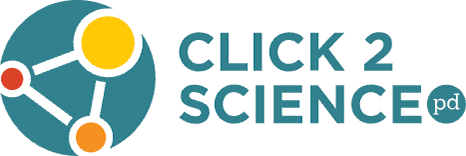PD Model & Framework

Click2Science Model of Professional Learning
A Process that Requires Time
Meaningful change that will improve program quality does not happen quickly. The Click2Science Professional Development model is designed to organize professional development that takes place over the course of a semester or whole year. It is a cycle that can be used once to develop a single skill, like Asking Purposeful Questions, or repeated as new skills are added and your team increases in their confidence and competence in STEM. Time for staff to practice what they are learning and apply it as they lead STEM activities is essential for meaningful change.
Needs Assessment
This model recommends that programs always begin with a needs assessment that focuses on program quality, your own observations, or staff feedback to identify a skill(s) that your program needs to focus on. The purpose and objectives for each skill will help you determine where to start.
Web Lesson
Staff begins the professional development cycle by completing a self-directed Web Lesson that corresponds to the skill you are working to improve. For example, if you’ve identified Encouraging Collaboration as the skill that staff needs the most support in, staff would complete the corresponding lesson title It Takes Two! Encouraging Collaborative STEM Work.
Training
The staff builds upon the knowledge developed in their self-directed learning experiences through hands-on, in-person training. Staff reflects upon the essence of the skill, what it looks like in practice, and how to use it during a STEM experience. The trainings are 60-120 minutes, include using the skill as part of a hands-on experience, and feature discussion around the video-based learning modules. These trainings are designed to be led by a group of staff and/or volunteers, to encourage social learning and rich discussion. Get started by browsing all training guides or reviewing our tips for using training guides.
Practice
Following the training, staff and volunteers are encouraged to practice using the skill while they lead STEM learning experiences with youth.
Meeting
Following up the training experience with a shorter piece of professional development encourages staff and volunteers to dig deeper into using the skill and discuss strategies as a group. These 15-60 minute professional development experiences are hands-on or discussion-based and feature the video-based learning modules to encourage reflection on practice to determine what works and what does not work when using this skill during STEM activities. Meeting guides can be used in an in-person staff meeting or virtual meeting. These experiences meet the needs of social, experiential, and visual learners. Get started by browsing all meeting guides or reviewing our tips for using meeting guides.
Practice
Staff and volunteers are again encouraged to practice the skill. Staff continue to practice the skill and reflect upon their practice to prepare for an in-person or virtual coaching session.
Coaching
The trainer/coach supports staff and volunteers by developing additional strategies for using the skills and setting improvement goals. The 15-30 minute coaching sessions use the video-based learning modules or videos staff and volunteers have recorded of themselves to reflect on their practice. Get started by browsing all coaching guides or reviewing our tips for using coaching guides.
Practice
Staff and volunteers are encouraged to continue to practice as they continue to develop the skill or begin the cycle with a new Click2SciencePD skill.
Evaluation
After completing a series of ongoing professional development experiences, evaluate the impact that these efforts have had on staff and your program. You can use formal program quality evaluation tools like DoS or use Click2Science self-confidence instruments to measure your staff’s confidence levels.
For a theoretical framework for this model, please see the following article:
Frerichs, S. W., Fenton, M. P., & Wingert, K. (2018). A model for out-of-school educator professional learning. Adult Learning. Retrieved from http://journals.sagepub.com/doi/full/10.1177/1045159518773908#articleShareContainer
